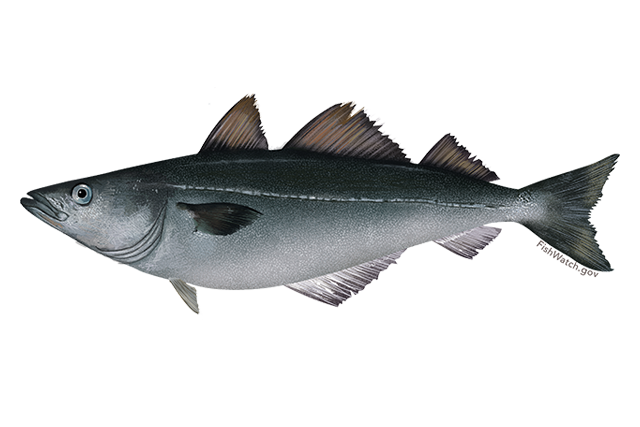Pollock
Species Description
Atlantic pollock Pollachius virens
also known as harbor pollock, Boston bluefish, coalfish, saith
Wild.
Pollock are a greenish hue, paling to yellow or smoky gray on the belly. A pale, lateral line contrasts with the dark sides. They look similar to cod and haddock, but for their solid greenish color and forked tail. They range widely throughout the cold waters of the Gulf, and inshore schools of juveniles are known as “harbor pollock” for their habitat preference.
Season
Year-round.
Status
Gulf of Maine Atlantic pollock are not overfished nor is overfishing occurring (Fishwatch.gov).
Regulatory Authority
New England Fishery Management Council under the Northeast Multispecies (groundfish) Plan.
Harvest Method
Trawl, gillnet, and some hook and line. See the vessel and gear guide for more information.
Recreational Harvest
Pollock will take an artificial lure or fly, and fight fiercely on the line. Pollock will also bite clams, minnows, or bait fish.
Maine territorial waters: no size or bag limits.
Federal waters: minimum size is 19 inches, and there is no bag limit.
Health Benefits & Risks
Pollock is a low-fat and low-calorie source of vitamin B12, phosphorus, and selenium. Pollock is low in mercury.
View the 2021 US Food and Drug Administration’s fish consumption guidelines.
Buying & Preparing
Atlantic pollock, distinct from the more common Alaskan or Pacific pollock, is available fresh and frozen in Maine. This white, flaky fish resembles haddock but has a richer flavor thanks to a higher unsaturated fat content, which also gives the meat a slightly darker color.
Recommended cooking methods include baking, broiling, frying, and smoking, all of which bring out its mild, flavorful profile.
Keep fresh pollock refrigerated and use within 1–2 days of purchase for best quality. If freezing, wrap tightly to prevent freezer burn and use within three months.
Recipes
Certifications & Verifications
Gulf of Maine Responsibly Harvested

